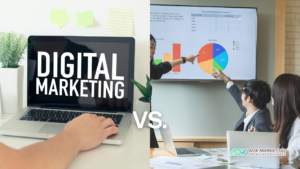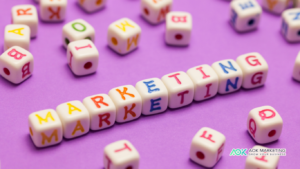As businesses try to adapt to the complexities of reaching their target audience, they are often faced with a critical decision: should they invest in digital marketing or stick with traditional marketing methods? Both strategies offer distinct advantages and can play a vital role in your marketing mix. In 2024, understanding the differences, benefits, and challenges of each approach can help you make informed decisions that maximize your marketing ROI.
In this article, we’ll explore the key differences between digital and traditional marketing, the pros and cons of each, and tips for determining which strategy is best for your business.

What Is Traditional Marketing?
Traditional marketing refers to the tried-and-true methods that have been around for decades. This includes:
Print advertising: Ads in newspapers, magazines, brochures, and flyers.
Broadcast advertising: TV and radio commercials.
Outdoor advertising: Billboards, posters, and signage.
Direct mail: Postcards, catalogs, and promotional letters.
Telemarketing: Cold calling potential customers.
For years, these channels were the primary means of reaching large audiences. Traditional marketing focuses on mass media, allowing businesses to target a broad demographic with a single message. However, with the rise of digital technology, traditional marketing methods are evolving to keep up with modern consumer behaviors.
What Is Digital Marketing?
Digital marketing involves promoting products or services through online channels. Some of the most common digital marketing methods include:
Search engine optimization (SEO): Improving a website’s visibility on search engines like Google.
Pay-per-click advertising (PPC): Paid ads on platforms like Google Ads or social media.
Content marketing: Creating and sharing blog posts, videos, and other content to engage an audience.
Social media marketing: Promoting your brand on platforms like Facebook, Instagram, and LinkedIn.
Email marketing: Sending newsletters, promotions, and product updates directly to subscribers’ inboxes.
Influencer marketing: Partnering with social media influencers to promote products to their followers.
Digital marketing is highly targeted and data-driven. It allows businesses to measure the success of their campaigns in real-time and adjust strategies based on analytics and customer behavior.
The Key Differences Between Traditional and Digital Marketing
When deciding between traditional and digital marketing, it’s essential to understand their key differences. These factors will help you determine which approach aligns with your brand goals and audience.
1. Reach and Targeting
Traditional Marketing: Typically offers broad reach. For example, a TV ad during a primetime show can reach millions of viewers, but the audience may not be highly targeted. Businesses pay to reach a wide range of consumers, many of whom may not be interested in their product or service.
Digital Marketing: Offers precision targeting. With tools like Facebook Ads or Google Ads, businesses can reach specific demographics, interests, and behaviors. Digital platforms allow for hyper-targeting, ensuring that your message reaches people most likely to convert.
2. Cost and Budgeting
Traditional Marketing: Can be expensive. Purchasing ad space in magazines, newspapers, or on TV and radio requires a substantial budget. The cost often correlates with the platform’s reach and popularity.
Digital Marketing: Is typically more budget-friendly. You can run digital campaigns with a small budget, especially with PPC ads or social media marketing. Additionally, you can track the ROI of digital campaigns more effectively, allowing for budget optimization.
3. Measurability
Traditional Marketing: Measuring the success of traditional marketing campaigns can be challenging. For example, it’s difficult to gauge exactly how many people viewed your billboard or responded to a radio ad.
Digital Marketing: Provides detailed analytics. Every click, view, and conversion can be tracked. With digital marketing, businesses have access to in-depth data and metrics like click-through rates, conversion rates, and engagement levels, allowing for immediate adjustments and improvements.
4. Engagement and Interaction
Traditional Marketing: Communication is one-way. You put your message out, and the audience receives it without the opportunity to interact with your brand in real-time. Traditional marketing methods like TV commercials or print ads do not encourage direct engagement from the consumer.
Digital Marketing: Encourages two-way interaction. Platforms like social media enable brands to engage directly with their audience. Customers can comment, share, and provide immediate feedback, creating an ongoing dialogue between the brand and its customers.
5. Longevity
Traditional Marketing: Tends to have a longer shelf life. For instance, a well-placed print ad or billboard can last for months and continue to generate brand awareness. However, it is difficult to update or modify once launched.
Digital Marketing: Campaigns can be short-lived but highly flexible. Digital ads can be quickly updated, paused, or adjusted based on real-time performance, ensuring your message stays relevant.
Pros and Cons of Traditional Marketing
Pros:
Broad Audience Reach: Traditional marketing allows you to reach a large and diverse audience, especially with TV, radio, and print ads.
Brand Credibility: Traditional media often carries a sense of credibility. TV or magazine ads can create a perception of reliability and trustworthiness.
Memorable Impact: Traditional ads can be more impactful in terms of visual or auditory appeal, especially TV and radio ads that use storytelling to create emotional connections.
Cons:
High Costs: Traditional marketing can be cost-prohibitive, particularly for small businesses with limited budgets.
Limited Measurability: Tracking the effectiveness of traditional campaigns is difficult, making it hard to determine the ROI.
Less Flexibility: Once a traditional ad is launched, it’s hard to make adjustments without incurring additional costs.
Pros and Cons of Digital Marketing
Pros:
Cost-Effective: Digital marketing offers a range of budget-friendly options, making it accessible to businesses of all sizes.
Targeted Reach: With digital marketing, you can hone in on specific demographics, interests, and behaviors, ensuring your message reaches the right audience.
Measurable Results: Digital platforms provide detailed insights and analytics, allowing you to track and optimize your campaigns in real-time.
Immediate Interaction: Brands can engage with consumers directly through comments, messages, and social media platforms, fostering stronger relationships.
Cons:
Constantly Evolving: Digital marketing trends change rapidly, requiring businesses to stay up to date with the latest tools, algorithms, and strategies.
High Competition: With everyone online, it can be challenging to stand out amidst the crowded digital space.
Which Strategy Is Right for Your Business?
Choosing between traditional and digital marketing depends on several factors:
Target Audience: If your audience is more traditional or if you’re targeting older demographics, traditional marketing may be more effective. However, if your target audience is younger and spends most of their time online, digital marketing is the clear choice.
Budget: Digital marketing is generally more cost-effective, especially for businesses with limited resources. Traditional marketing, while effective, can require a larger investment.
Business Goals: If you’re looking for immediate interaction and measurable results, digital marketing is the better option. Traditional marketing may work better for long-term brand awareness and credibility.
Final Thoughts
In 2024, both digital and traditional marketing have their merits, and the best strategy for your business will depend on your unique goals, audience, and budget. For many brands, a mix of both approaches may provide the most effective results. By understanding the strengths and limitations of each, you can create a well-rounded marketing strategy that reaches your audience where they are and maximizes your return on investment.
About The Author
Khalid Essam
Khalid is the Chief of Staff at AOK. He collaborates with a team of specialists to develop and implement successful digital campaigns, ensuring strategic alignment and optimal results. With strong leadership skills and a passion for innovation, Khalid drives AOK’s success by staying ahead of industry trends and fostering strong client and team relationships.





